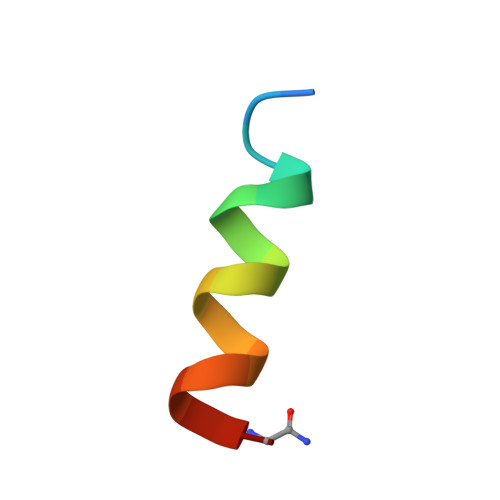Exploring the trigger sequence of the GCN4 coiled-coil: Biased molecular dynamics resolves apparent inconsistencies in NMR measurements
Missimer, J.H., Dolenc, J., Steinmetz, M.O., van Gunsteren, W.F.(2010) Protein Sci 19: 2462-2474
- PubMed: 20954244
- DOI: https://doi.org/10.1002/pro.528
- Primary Citation of Related Structures:
2L56 - PubMed Abstract:
Trigger sequences are indispensable elements for coiled-coil formation. The monomeric helical trigger sequence of the yeast transcriptional activator GCN4 has been investigated recently using several solution NMR observables including nuclear Overhauser enhancement (NOE) intensities and 3J(HN, HCα)-coupling constants, and a set of 20 model structures was proposed. Constrained to satisfy the NOE-derived distance bounds, the NMR model structures do not appear to reproduce all the measured 3J(HN-HCα)-coupling constant values, indicating that the α-helical propensity is not uniform along the GCN4 trigger sequence. A recent methodological study of unrestrained and restrained molecular dynamics (MD) simulations of the GCN4 trigger sequence in solution showed that only MD simulations incorporating time-averaged NOE distance restraints and instantaneous or local-elevation 3J-coupling restraints could satisfy the entire set of the experimental data. In this report, we assess by means of cluster analyses the model structures characteristic of the two simulations that are compatible with the measured data and compare them with the proposed 20 NMR model structures. Striking characteristics of the MD model structures are the variability of the simulated configurations and the indication of entropic stability mediated by the aromatic N-terminal residues 17Tyr and 18His, which are absent in the set of NMR model structures.
- Laboratory of Biomolecular Research, Paul Scherrer Institute, CH-5232 Villigen, Switzerland.
Organizational Affiliation:
















